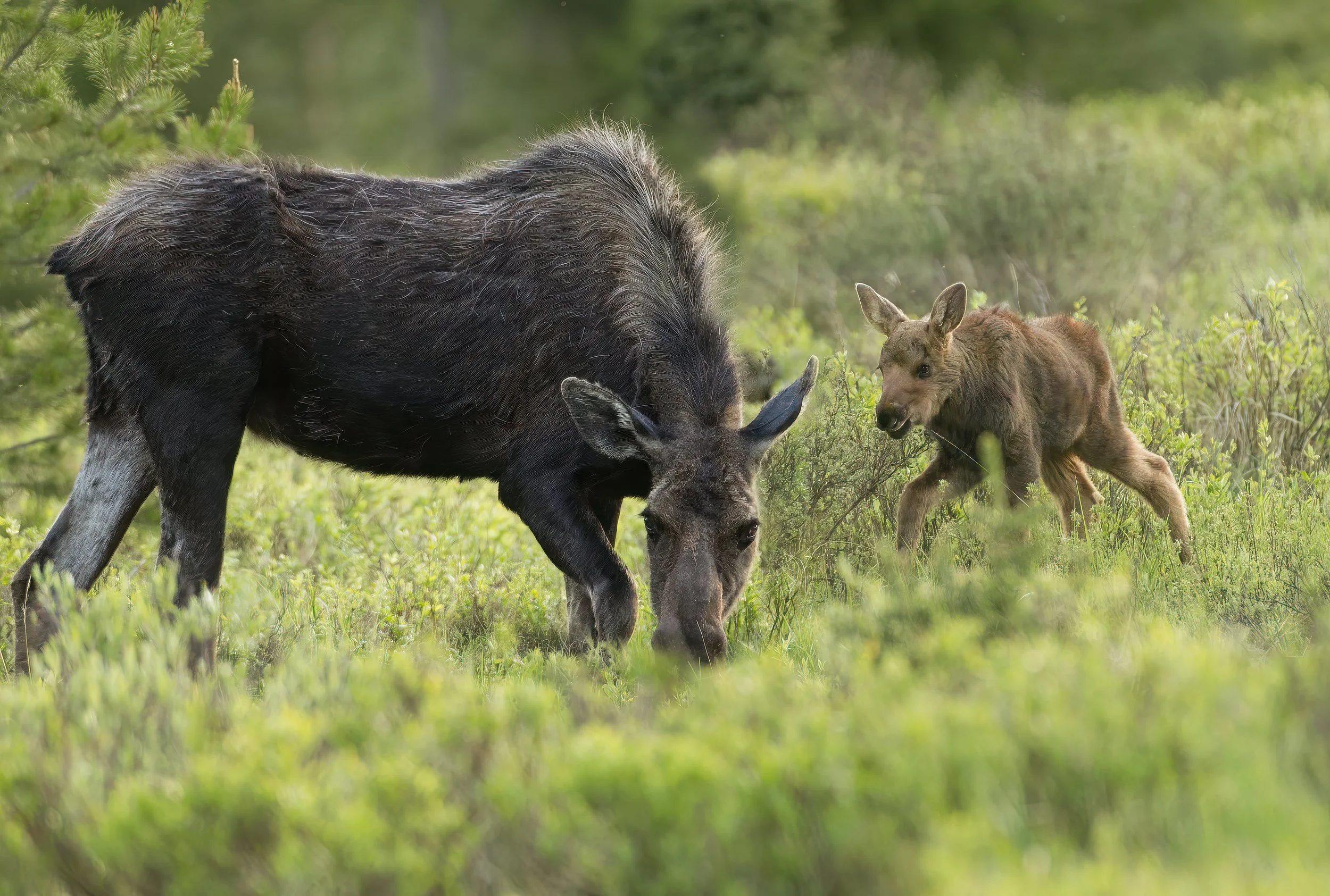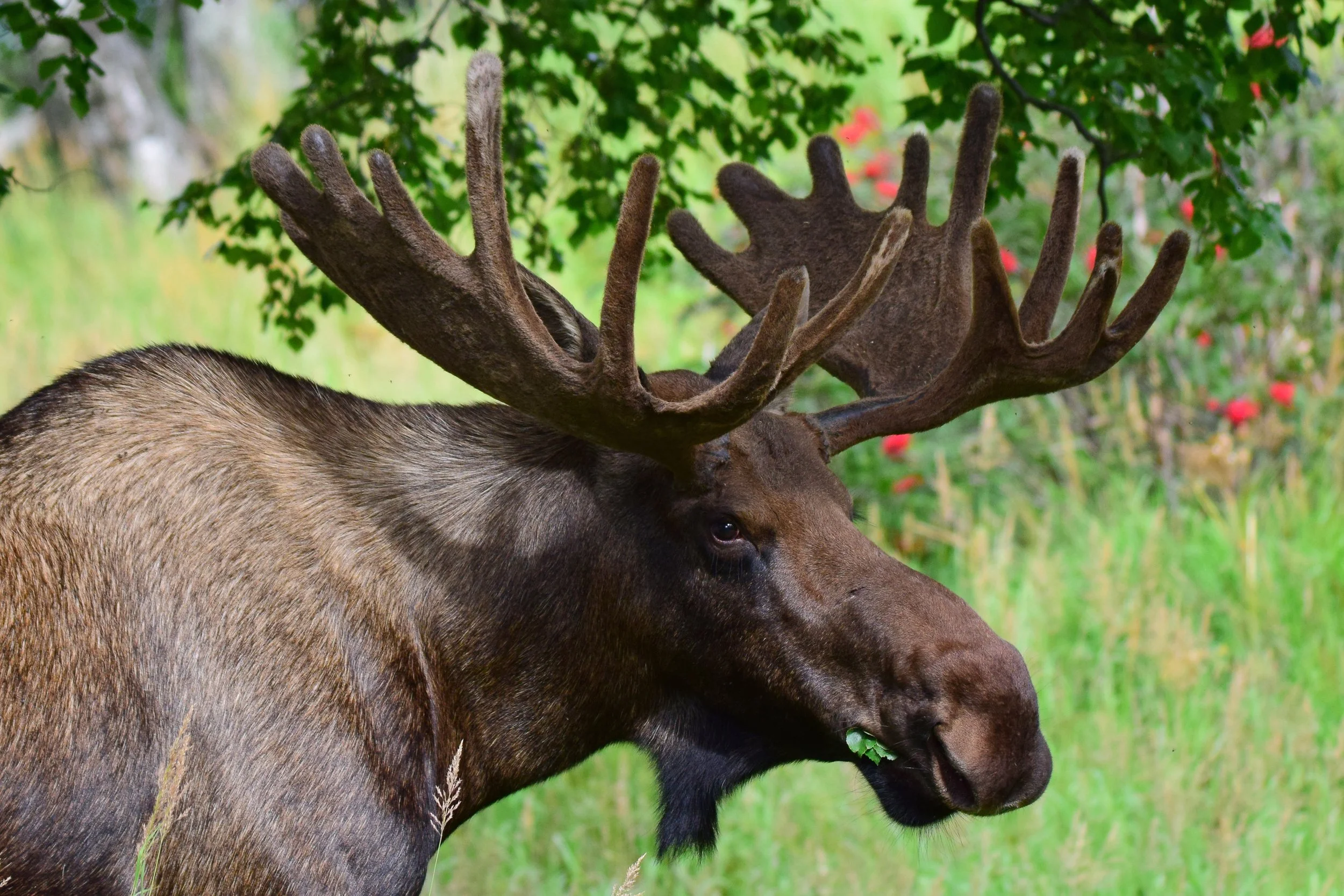Fun Facts About Moose
-
• Moose live in northern snow forests all around the globe. On the Eurasian continent, they are called “elk.” In North America, elk are also called by the Native American name Wapiti.
-
• Antlers grow only on male moose. Made of bone, they sprout from the bull’s forehead each spring, reach full size by mating season, fall off in the winter, and grow back even bigger starting the next spring.
-
• Fallen antlers are not wasted. Rich in calcium and other minerals, they are quickly gnawed away by porcupines and other rodents.
-
• A dewlap—that funny dangling beard, or “bell”—is a mystery. Scientists don’t what it’s good for, but it’s surely decorative.
-
• Moose are “browsers,” eating mostly leaves, twigs, and shrubs. Bison, by contrast, are mainly grazers, eating grass and weeds. Because vegetation is hard to digest, both groups of animals have more than one stomach and chew their cuds.
-
• Moose are great swimmers, even as calves. Adults have been observed paddling up to 12 miles (20 k) without stopping. Moose can also dive underwater for food.
-
• Moose calves grow up really quickly. They can walk within hours of birth, live on their own at a year and a half, and become parents in two or three years.
-
• Moose are great runners. Adults have been clocked running 35 miles an hour (56 km/hr), which is faster than the fastest human sprinter. Baby moose can run within days of birth.
-
• Moose grow up to be really big. The biggest of all are Alaskan moose (Alces alces gigas). An Alaskan bull can weigh over 1600 pounds (725 kg) and measure 7 feet (215 cm) high at the shoulder. Add the head and antlers, and he could reach 9 feet (275 cm) tall.
-
• Moose don’t mind cold weather. Their two-layered winter coats, with hollow outer hairs, trap air like a thermal blanket or parka. Snow can sit on a moose’s back without melting! Even in their summer coats, moose get uncomfortable if the temperature rises beyond 59 degrees Fahrenheit (5.1 C).
-
• Moose milk is enjoyed by humans, too! Some Russians think it helps people with stomach problems. And in Sweden, moose cheese is a gourmet item.
-
• Moose poop is mushy (like cow pies) in the summer. But in the winter, when food is dry and water scarce, moose drop piles of oblong pellets. Some people collect these moose “nuggets” to decorate jewelry or key chains!
-
• Two countries compete for the biggest moose statue in the world: Canada (Moose Jaw, Saskatchewan), and Norway (on Route 3, Hedway region). Canadians recently enlarged the antlers of Mac the Moose so that, at 34 feet (10.36 meters), it is now the tallest.
-
• A wild moose can be dangerous. Don’t even think of taking a selfie! Go right into a building or car. If you are on foot, leave the area immediately or climb a tree. And never approach a moose calf; its mother is probably nearby and a threat to you. If you think a calf may be sick or orphaned, notify a ranger or animal rescue center.
Glossary
Antlers. Made of bone, antlers sprout from the foreheads of male moose and other members of the deer family. Unlike the horns of cattle, sheep, goats, and antelope, antlers are temporary. They grow each summer for the fall mating season, are shed in the winter, and grow back bigger the next summer. A pair of moose antlers (rack) can be over 6’ (180 cm) wide.
Bond. The strong emotional attachment between two creatures, like a baby and its mother. This bonding process in some species is almost instantaneous. But moose may take a little longer to bond, which is why a mother moose keeps her baby alone with her for the first few days.
Browse. Leaves, twigs and other parts of woody plants. Also a verb: to browse on browse. Moose are mostly browsers. But in the summer, when grass and other annual plants are available, they will also graze.
Bull. An adult male moose. An adult female is a cow, while her child is a calf. The same terms are used for several other large mammals, including bison, elk, elephants, giraffes, whales, elephant seals, and walruses.
Cud. Partly digested food brought up for more chewing. Moose chew their food twice. In between, they swallow the food into a rumen—a special stomach chamber with enzymes that help break down the tough cellulose in plant material. After the second chew, the cud goes to another stomach chamber to continue the digesting process. Animals with rumens are called ruminants, and include cattle, deer, sheep, goats, and antelopes.
Moose. The largest member of the deer family, species name Alces alces. Like “deer” and “sheep,” this noun can be singlular (one animal) or plural (meaning two or more). The name “Moose” comes from a Native American (First Peoples) word for “twig eater.” (In Europe, Alces is called “elk,” while in North America, “elk” is the name for another large deer species, Cervus elapses, also called “wapiti.”)
Muzzle. An animal’s upper lip and nose, which in a moose are especially large and versatile. The flexible lip can test for tenderness, then grab and tear off food. The nose detects odors much better than the human nose. And within the nose are fatty pads that can squeeze shut; water doesn’t get up a moose’s nose!

